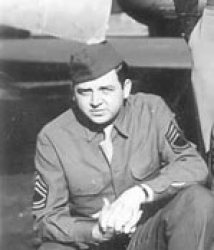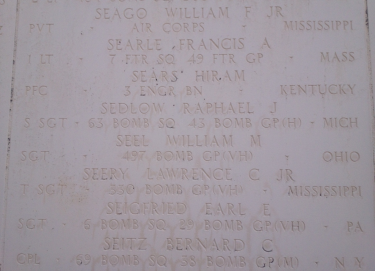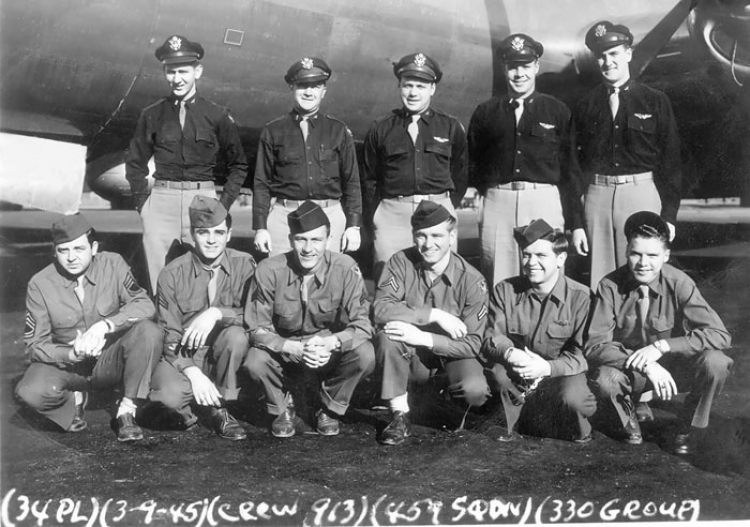
 |
|
|
||
|
Lawrence C. Seery, Jr. 'Dood' |
||||
|
Engagements: • World War II (1941 - 1945) |
||||
| Biography: | ||||
|
Lawrence C. Seery Jr. Lawrence C. 'Dood' Seery, Jr. was born on 16 April 1920 in West Point, MS, the only son of Lawrence and Emma Seery. Lawrence enlisted in the U.S. Army on 4 December 1941 at Camp Shelby, MS. He wanted to become a pilot, but an old football injury prevented him from passing the medical physical required to enter pilot training. However, he was assigned to the U.S. Army Air Forces and trained as a Flight Engineer. On 24 April 1945, Technical Sergeant Seery was serving with the 459th Bombardment Squadron, 330th Bombardment Group (Very Heavy), 20th Air Force, as the Flight Engineer on aircraft K-63 (42-94047), a B-29 Superfortress bomber with a crew of 11. His unit flew missions in Japan out of North Field in Guam. Just eight days earlier, Dood Seery had celebrated his 25th birthday. TSGT Seery * and the crew of K-63 had just returned from a bombing run earlier that day, and they were ordered to refuel and join a group of 11 aircraft assigned to bomb the large Hitachi aircraft factory at Tachikawa (a suburb of Tokyo), Japan. The factory was heavily defended by both fighter aircraft and anti-aircraft batteries. The approach and bomb run was normal, with K-63 flying in the tail-end position of the formation. In the target area, the group of bombers encountered intense fighter attacks and flak bursts. As the bombers flew out of the area of the most intense fighting, they began accounting for each B-29 in the formation. The rear gunners of the other aircraft in the group stated that aircraft K-63 was no longer in formation, but it was thought to be some distance behind and apparently crippled by flak and the numerous fighter attacks. It was also possible that some members of the crew had been wounded. * (Seery had been notified that he would receive a commission as a Second Lieutenant, but died before the promotion became official.) At this point, the crew of K-63 was struggling with an aircraft with one engine inoperative and a second engine losing power, which had prevented them from dropping their bombs on the primary target. However, the dedicated crew was still determined to make effective use of their bombs by dropping them on a secondary target near the coast of Japan. While on the bombing run, or just after releasing the bombs, the crew of the 'buddy' ship assigned to assist K-63, observed three objects leaving the aircraft. Two of the objects were crew members and their parachutes opened. The third object might have been a crew member but, if it was, his chute was not seen to open while in sight of the 'buddy' crew. Radio contact later confirmed that the navigator, radar operator, and radio operator had parachuted from the craft. The K-63 aircraft struggled while losing power, speed, and altitude until it was ditched in the sea some 80 miles from Japan in fairly rough seas. The B-29 broke into two pieces and sank quickly. The crew of the 'buddy' aircraft observed what they believed to be six crew members leaving the crashed plane and getting into life rafts. Their position was carefully plotted and air-sea rescue groups were informed. Due to the distance, and other planes being in similar trouble, the 'buddy' ship couldn’t remain in the crash area until a rescue was completed. Later in the day, although several attempts were made to search the area in adverse weather, no rescue was accomplished. The crew of aircraft K-63, one of the 459th Squadron's best air crews, was never recovered. The fate of the remaining crew members is unclear ... whether they perished at sea, or were killed by Japanese Naval vessels. Less than 4 months later, Japan surrendered on 15 August 1945. Survivors It was later learned that the three crew members that bailed out of the bomber did survive their jump, although they did not see each other for ten days. All three men were captured and then placed in a POW camp near Nagoya where they spent the next 5 months with other American prisoners from Bataan and Corregidor, British prisoners from Hong Kong, and Australian prisoners from Java. The three men who survived were: 2LT George R Farmer (navigator); CPL Ronald F Heemann (radar operator); and PFC Eldon A Peterson (radio operator). Medals, Awards and Badges
Purple Heart [The information and photos for this Honoree Record were furnished by Monica Abner, TSGT Seery's niece.] |
||||
| Honoree ID: 101607 | Created by: MHOH | |||
Ribbons
Medals
Badges
Honoree Photos
 |  |  |
 |  |
 |


